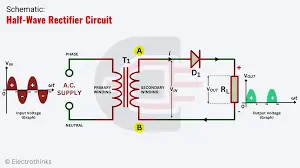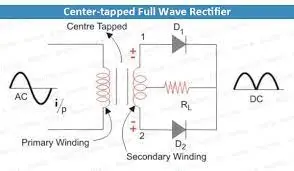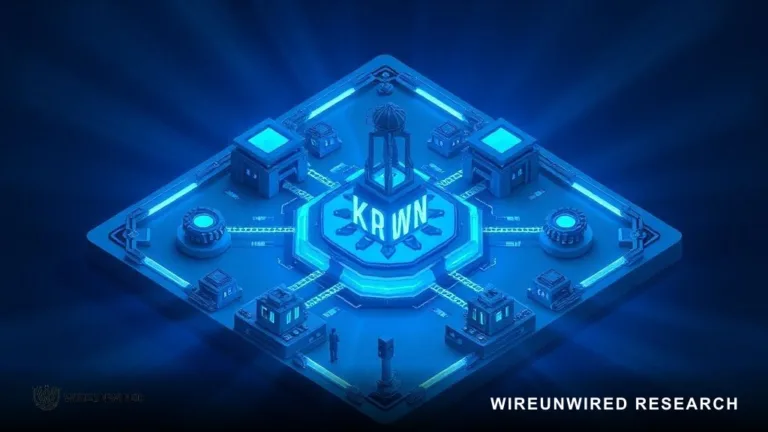A rectifier is a device that converts alternating current (AC) to direct current (DC). Rectifiers are used in many applications, such as power supplies, battery chargers, radio receivers, and signal processing. There are two main types of rectifiers: half-wave rectifiers and full-wave rectifiers. In this blog post, we will compare the advantages of fa full-wave rectifier over a half-wave rectifier.
What is a Half Wave Rectifier?
A half-wave rectifier is a simple circuit that uses a single diode to allow only one-half of the AC input cycle to pass through. The other half of the cycle is blocked by the diode. The output of a half-wave rectifier is a pulsating DC voltage that has the same frequency as the input AC voltage.

img source :https://byjus.com/
What is a Full Wave Rectifier?
A full wave rectifier is a circuit that uses two or four diodes to allow both halves of the AC input cycle to pass through. The diodes are arranged in such a way that they reverse the polarity of the negative half cycle and make it positive. The output of a full wave rectifier is also a pulsating DC voltage, but it has twice the frequency as the input AC voltage.

There are two types of full-wave rectifiers: center-tapped full-wave rectifiers and bridge full-wave rectifiers. A center-tapped full wave rectifier uses a transformer with a center-tapped secondary winding and two diodes. A bridge full wave rectifier uses four diodes and does not require a center-tapped transformer.
Advantages of Full Wave Rectifier over Half Wave Rectifier
The following are some of the advantages of full wave rectifier over half wave rectifier:
Efficiency:
The efficiency of a rectifier is defined as the ratio of the DC output power to the AC input power. The efficiency of a full-wave rectifier is higher than that of a half-wave rectifier because it converts both cycles of AC to DC. The efficiency of a full-wave rectifier is about 81%, while that of a half-wave rectifier is about 40%.
Output Power:
The output power of a rectifier is the product of the DC output voltage and the DC output current. The output power of a full-wave rectifier is higher than that of a half-wave rectifier because it produces more DC output voltage and current. The output power of a full-wave rectifier is about four times that of a half-wave rectifier.
Ripple Factor:
The ripple factor of a rectifier is a measure of how smooth or pulsating the output DC voltage is. The ripple factor is defined as the ratio of the root mean square (RMS) value of the AC component to the DC component of the output voltage. The lower the ripple factor, the smoother the output DC voltage. The ripple factor of a full-wave rectifier is lower than that of a half-wave rectifier because it has a higher ripple frequency and lower ripple amplitude. The ripple factor of a full-wave rectifier is about 0.48, while that of a half-wave rectifier is about 1.21.
Filtering:
Filtering is the process of removing or reducing the AC component from the output DC voltage using capacitors, inductors, or both. Filtering improves the quality and stability of the output DC voltage. Filtering is easier for a full-wave rectifier than for a half-wave rectifier because it has a lower ripple factor and higher ripple frequency. A simple filter circuit can be used for a full-wave rectifier, while a more complex filter circuit may be required for a half-wave rectifier.
Transformer Utilization Factor:
A rectifier’s transformer utilization factor (TUF) measures how well the transformer’s secondary winding is utilized. The TUF is defined as the ratio of the DC power delivered to the load to the AC rating of the transformer secondary winding. The higher the TUF, the better the transformer utilization. The TUF of a full-wave rectifier is higher than that of a half-wave rectifier because it utilizes both halves of the transformer’s secondary winding. The TUF of a bridge full wave rectifier is about 0.812, while that of a center-tapped full wave rectifier is about 0.672, and that of a half wave rectifier is about 0.287.
Conclusion
In conclusion, we can say that a full-wave rectifier has many advantages over a half-wave rectifier in terms of efficiency, output power, ripple factor, filtering, and transformer utilization. A full wave rectifier is more suitable for applications that require high and smooth DC output voltage and current, such as power supplies, battery chargers, and signal processing. A half-wave rectifier is more suitable for applications that require low and pulsating DC output voltage and current, such as signal detection and modulation.
To learn more about full-wave and half-wave rectifiers Click Here.
Discover more from WireUnwired Research
Subscribe to get the latest posts sent to your email.




